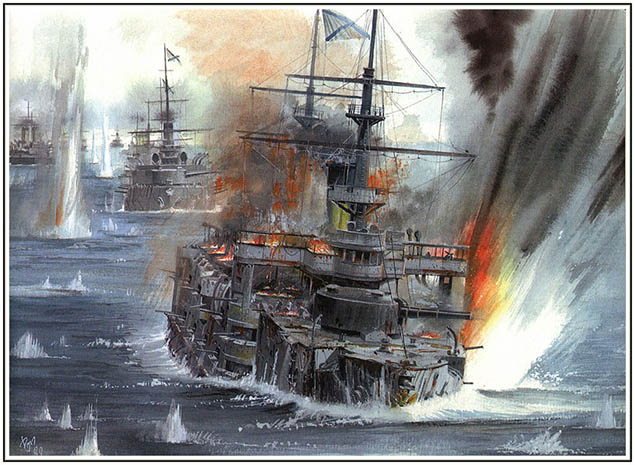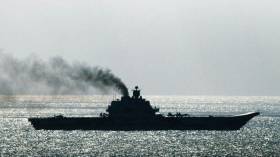Displaying items by tag: Russian Navy
Jinxed Giant Russian Aircraft Carrier Still Packs A Mighty Punch
The recent stately progress through the English Channel of the giant Russian Aircraft Carrier Admiral Kuznetsov and the Battle Cruiser Peter the Great in a flotilla of eight warships bound for the Eastern Mediterranean has been a matter of fascination for naval historians and many others writes W M Nixon.
But anyone who has ever had trouble with faulty injectors causing their marine diesel engine to belch black smoke will have felt a twinge of sympathy for the team trying to keep the Kuznetov show on the road. For even as the still rakish-looking thirty year old carrier hove into view, the first thing any boat-owner would have noticed was the huge volume of dark grey and often black smoke billowing from the mighty smokestack.
And it wasn’t just a brief interlude of smoke-making when they gave the old ship a bit of throttle to get her past the White Cliffs of Dover with a bit of style. On the contrary, there was always foul-looking smoke pouring out – the only change that came from time to time was just how much.
It turns out that the flagship of the Russian navy – built between 1982 and 1990 – has always been regarded as a bit of a jinxed ship, with such a history of engine breakdown that she never goes anywhere without her own personal tugboat in attendance, just to be sure to be sure.
So you would feel sorry for the Chief Engineer charged with the task of keeping her in action, for after a day of getting covered in muck keeping those pesky engines going, chances are that he’ll not be able to have a refreshing shower at the end of his watch, as half the ship’s plumbing systems have never worked properly, if at all.
But however she gets to her destination, the fact is that when the engines are running at all she can build up to an impressive speed. And even if she has to be towed ignominiously to a strategic location, once she’s there her huge force of aircraft add a completely new dimension to any war situation. Thus the eventual presence of the Kuznetsov in the Eastern Mediterranean will be a major bargaining chip in deciding the future of the beleaguered city of Aleppo in Syria.
So black smoke or not, this is a formidable warship which can do the business if called upon. It’s all decidedly different from the episode back in 1904, when Imperial Russia and the Empire of Japan were at war over Russia’s ambition to maintain a year-round naval base on the Pacific.
There, their own port of Vladivostock in eastern Siberia was inaccessible in winter ice, but a leased base further south at Port Arthur in Manchuria provided the facilities required. Howeve, Imperial Japan didn’t want the Russians being a naval presence in the Pacific, so in a surprise attack on 8th February, they more or less wiped out the Russian Pacific Fleet.
This caused a certain indignation in the palaces of Imperial Russia, where it was decided the only appropriate response was to send virtually the entire Russian Baltic Fleet to the Far East to teach the Japanese a lesson. It was a Quixotic endeavor from the start, and it took all of seven months, using half a million tons of coal.
The naval officers in charge – ancient Russian aristocracy of heroic incompetence – had rather hoped their voyage would take them through the Solent, where they could stop off at Cowes or Portsmouth and host gala balls for the English aristocracy. But unfortunately in going through the North Sea, the excitement of having exited the Baltic was too much for one ship’s crew, and they opened fire on English fishing boats on the Dogger Bank under the impression they were Japanese gunboats.
The result of this was that any invites to the Royal Yacht Squadron at Cowes were off, and worse still the Russians weren’t even allowed to take the short cut through the Suez Canal, resulting in the logistical nightmare of finding places to re-coal as they made their stately progress round the Cape of Good Hope.
Finally, after many miles of meandering up through the Indian Ocean and the myriad of islands between it and their destination, the gallant Imperial Russian Baltic Fleet met up with the numerically superior Navy of the Empire of Japan in the Straits of Tsushima on May 27th 1905. By May 28th, two-thirds of the Russian fleet of 38 vessels – including six First Class battleships – had been annihilated, while the remainder were beyond use.
 The Battle of Tsushima (27-28 May 1904) saw the Imperial Russian Baltic Fleet lose six First Class Battleships to the Navy of the Empire of Japan
The Battle of Tsushima (27-28 May 1904) saw the Imperial Russian Baltic Fleet lose six First Class Battleships to the Navy of the Empire of Japan
After this debacle and other setbacks, the Russian Revolution of 1917 was only a question of time. Today, Russia’s navy is a very different animal to that quaint fleet of 1904. So though we may feel a certain sympathy for the toiling ship’s engineers who labour with ingenuity in impossible conditions to keep the Admiral Kuznetsov in action, you certainly wouldn’t want to see her moored off your lawn. And Gala Balls with dashing Tolstoyan officers are definitely not on the agenda.
Rare Opportunity As Russian Destroyer Opened to the Public
#RUSSIAN NAVY - While Dublin Port was visited by USS Fort McHenry (LSD-43) over the last week, the Russian Navy's Vice-Admiral Kulakov (626) paid a courtesy call to Cork Harbour, berthing at Cobh, normally associated with frequent cruise callers, writes Jehan Ashmore.
The imposing Udaloy anti-submarine destroyer berthed alongside Cobh's deepwater quay last week, where the public had rare access to board the 162m destroyer commissioned in 1982.
Later this month the Cork Harbour Open Weekend (15-16th Sept) as previously reported on Afloat.ie will offer two-days of fun filled activities for all ages, with events and activities for all, both on and off the water.
Russian Naval Destroyer Departs Dublin
The 534ft long vessel was built for the KGB Maritime Border Guard and is heavily equipped with missiles, torpedoes, guns and the ability to carry helicopters.
Admiral Chabaneko had arrived on Friday afternoon and docked at berth 30 in the inner port area within Alexandra Basin West. The last Russian naval visit was taken by one of her half-sisters, Severomorsk, a Udaloy-I class destroyer that docked at Ocean Pier in Alexandra Basin East for a three-day visit in 2009.
Rare Russian Naval Call Due to Dublin Port
Admiral Chabaneko was built by Yantar Zavod in Kaliningrad, and her sister Admiral Basisty though she was cancelled and scrapped in 1994. In 1996 Admiral Chabaneko was transferred to the Russian Navy but was not commissioned until two years later. In 1999 she changed naval base from Baltysk to Severomorsk to take up service in the Northern Fleet.
The last such call by the Russian Navy to Dublin was by her half-sister, Severomorsk, one of over a dozen of the original Udaloy-I class destroyers built, which made a three-day visit to the capital in 2009.
Severomorsk had arrived from Cherbourg after completing in FRUKUS 2009, an international naval anti-piracy exercise in the North Atlantic. The five-day exercise was held off the Brest and included a Tourville class frigate from the French navy, the UK's HMS York and USS Klaking.



























































